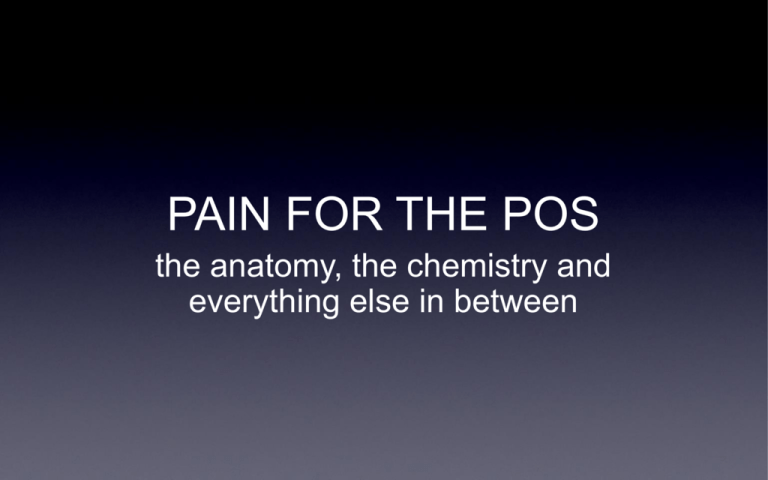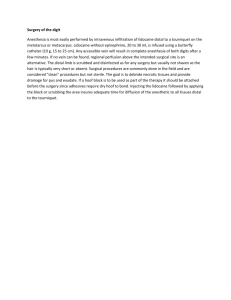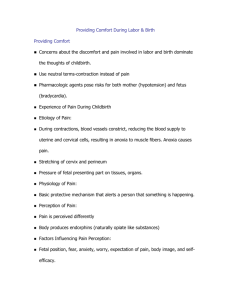local anesthetics
advertisement

PAIN FOR THE POS the anatomy, the chemistry and everything else in between Tissue injury produces a biphasic response •Peripheral sensation •Excitatory neurotransmitters •Chemical mediators of the inflammatory response (substance P, prostaglandins, leukotrienes, bradykinin, serotonin and histamine) • • Central sensation Afferent traffic from the site of injury and activation of excitatory amino acid NMDA receptors in the spinal cord NSAIDS • largely due to the inhibition of cyclooxygenase which prevents the formation of prostglandins and thromboxanes • COX -1 present in all tissues • COX- 2 produced primarily at the ssite of inflamation central sensitization • afferent traffic from the site of injury and activation of excitatory amino acid NMDA receptors in the spinal cord • amplification of afferent nocioceptive input by expansion of receptive fields with in the CNS the anatomy • • • • mixed nerves that contain both afferent and efferent fibers each axon is surrounded by endoneurium -non neural glial cells individual nerves are bundled into fascicles and and surrounded by perineurium -connective tissue the entire peripheral nerve is wrapped in epineurium composed of dense connective tissue nerve fiber classification • size • conduction velocity • function • the more myelin and the bigger the nerve the faster the conduction velocity nerve A-alpha, A-beta A-delta B C diameter 6-22 1-4 <3 0.31.3 myelin + + + - conduction location fastes t muscles a/e joints, and muscles propriocepti on 6x afferent function pain, touch, temp slower sensory nerves 1.5 x sympathetic auto sympathetic auto, pain, temper slower 5-10x slowe r resting membrane potential • • resting memnrane potential of most nerve cells is - 60 to -90 mV. cells at rest are more permeable to K+ ions and because the concentration of K+ is about 30 x greater inside the cell than outside depolarization • • when the cells are active, Na+ channels are openedand the Na+ permeability increases so the membrane potential becomes less negative if the membrane potential increases enough additional Na+ channels open and a wave is propagated along the axon action of LA • local anesthetics prevent the opening of Na+ channels and prevent the membrane potential from increasing sufficiently to open additional Na+ channels The problem is that the Na channels need to be blocked from inside the cell! acidic alkaline influenced by pH of surroundings lipid insoluble do not cross cell membranes LA H + lipid soluble LA + H+ pKa the pH at which the ratio of ionized to non-ionized molecules is 1:1 dissociatic constant ambient pH < pKa ambient pH> pKa weak acid more ionized more unionized (lipid insoluble) weak base more ionized more unionized (lipid insoluble) local anesthetics • • • poorly soluble weak bases with pKa> 7.4 ( ie predominantly ionized at a neutral pH consist of a hydrophobic portion ( tertiary amine) and hydrophobic portion (unsaturated amine ring) linked by ester or amide modification of the chemical structure alter potency, rate of metabolism and duration of action lidocaine • • pK of lidocaine is 7.7(7.9)and the acid solution has a pH of 6 ( hydrochloride salt) lidocaine hydrochloride solution in a syringe 99% of the total is in the ionized form and 1% is in the non-ionized form. once injected .... • • • injected into the tissues, where the pH is 7.4 the ionized portion drops to 76% 24% is now non-ionized or lipid soluble able to diffuse passively down the concentration gradient across the nerve cell membrane through the cell membrane • • • the pH is now 7.1 shifts the equilibrium between the ionised and non- ionized form 86% of the total is now back towards the ionized • • ionized form now means that it can pass into and block the sodium channels reduces the amount of non-ionized form on the inside of the cell to increase the concentration gradient across the cell membrane diffuses across the membrane in the unionized form ( degree of ionization depends on pKa of LA and pH of the tissues in acidosis so the more LA in ionized form, degree of penetration less) mechanisms of blockade • sodium channel blockade leads to a reduction in the action potential formation and propagation • animal studies suggest that there must be a decrease in 50% of the action potential before a loss of function is observed frequency dependent block • • • open sodium channels are more susceptible to local anesthetic binding than those in a closed state the higher the frequency of stimulation the more intense the block nerves that carry high frequency impulses (sensory nerves) are more susceptible to blockade than low frequency impulses (motor nerves) do local anaesthetics block the smallest fibers first? • • • small myelinated axons - gamma and delta are most sensitive large myelinated - alpha and beta least susceptible the small non-myelinated C fibers nerve A-alpha, A-beta A-delta B C diameter 6-22 1-4 <3 0.31.3 myelin + + + - conduction location fastes t muscles a/e joints, and muscles propriocepti on 6x afferent function pain, touch, temp slower sensory nerves 1.5 x sympathetic auto sympathetic auto, pain, temper slower 5-10x slowe r local anesthetic block of nerve fibers • depend on size and type of fibre • frequency of membrane stimulation • choice of local anesthetic blockade is incomplete • • • partially blocked fibers are further inhibited by repeated stimulation one local anesthetic binding site may be enough to account for the resting and use dependent actions but the route to this single site may be multiple pathways clinically relevant rates of onset and recovery are governed by the slow diffusion both in and out of the nerve as a whole NOT to the faster binding to sodium channels structure/ function characteristics speed of onset pKa duration of action related to 1) lipid solubility 2) protein binding - increases the duration of action potency aromatic ring structure and increase hydrocarbon length determine lipid solubility so what are these drugs? • local anesthetics are agents that produce a reversible blockade of neural transmission in autonomic, sensory and motor fibres depending on the concentration applied through binding to fast sodium channels in the axon membrane -preventing depoarization and action potential propagation O C R O N R esters commonly used esters • procaine • chloroprocaine • cocaine • tetracaine esters • • • unstable in solution rapidly hydrolysed by plasm cholinesterase more commonly associated with allergies esters • Metabolized by pseudocholinesterase • Hydrolysis occurs at the ester linkage and yields an alcohol and para-aminobenzoic acid • May be prolongs in people with liver disease, neonates and atypical cholinesterase carriers of the following local anesthetics , which is not an ester ? • procaine • lidocaine • tetracaine • cocaine • all of the above O R N C N R amides commonly used amides • lidocaine • bupivacaine • mepivacaine • ropivacaine lidocaine • • • • Rapid onset and medium duration of onset Amide anesthetic and a class 1b anti- arrhythmic drug Maximum dose 3 mg without epinephrine - 7 mg with epinephrine Local infiltration, topical anesthesia, epidurals, what the maximum lidocaine dose you can use in 20 kg boy using 1% lidocaine with epinephrine • 6cc • 8cc • 10 cc • 12 cc • 14 cc bupivicaine • • • • • Amide anesthetic Slow inset with a prolonged duration of action Maximum safe dose 2.5 mg Particularly cardiotoxic (it enters the Na channel fast but diffuses out slowly Spinal and epidural anesthesia, nerve blocks, local infiltration with respect to lidocaine • bupivicaine has a slower onset • pKa is more acidic • the maximum safety dose is under 500 mg the adjustment of lidocaine dose is necessary in the patient with which one of the following • hepatic insufficiency • renal insufficiency • patient with CHF • respiratory insufficiency • patient on propanolol onset of action • site and type of nerve • proximity of the injection • pKa of local anesthetic agents • acidity of surroundings systemic absorption • • • • • decreased systemic absorption will have a greater margin of safety most important the site of injection the dose the physicochemical of the local anesthetic greater the vascularity the faster the absorption the amount of fat in the surrounding areas potency • the higher the lipid solubility, the greater the potency duration of action • • • • • • dose local blood flow intrinsic vasoactivity vasoactive additives protein binding local drug metabolism protein binding • • • amide anesthetics are primarily protein bound bupivicaine, levobupivicaine and ropivicaine are more than 90% bound to1 alpha acid glycoproteins ( high affinity) and albumin ( high volume and low affinity) free or unbound fraction of the local anesthetic is active distribution • • • • organ blood flow partition coefficients of local anesthesia between compartments plasma protein binding organ regional pharmacokinetics children • • • infants less than 6 months of age have decreased levels of plasma proteins adult levels of binding are reached about one year of age alpha one glycoproteins increase with surgical stress, which in turn will decrease the free fraction of anesthetic patient status • • • • age immature enzyme pathways decreased hepatic blood flow impaired hepatic enzymes elimination • ester anesthetics are eliminated by plasma cholinesterases • amide anesthetics are dependent on clearance by the liver • hepatic extraction, hepatic perfusion, hepatic metabolism and protein binding are going to influence the rate of clearance Methemoglobinemia • • • • prilocaine is metabolized to O-toluidine result is a hemoglobin that is less able to bind oxygen fetal hemoglobin is much more sensitive to the metabolite appear cyanotic and cause interference with the pulse oxymetry duration of action • • • • • • dose local blood flow intrinsic vasoactivity vasoactive additives protein binding local drug metabolism epinephrine • • • • prolongation of local block increased intensity if the block decreased systemic absorption of local anesthetic antagonizing inherent vasodilation of local anesthetics bicarbonate • • • • pH of local anesthetic solutions commercially prepared ranges from 3.9 to 6.47 less than 3% of the commercial preparations exist as the lipid soluble neutral form rationalization to increase the lipid soluble form why not at Mac? onset of the block is only five minutes faster α 2 adrenergic agonists • • • • clonidine produces analgesia via supraspinal and spinal adrenergic receptors it also has direct inhibitory effects on peripheral nerve conduction may be synergistic if given intrathecaly not approved in Canada for routine use lipid relative potency protein binding duration Pka onset procaine low 0.5 6 short 8.9 slow bupivicaine high 4 96 long 8.1 slow 7.7 rapid 8.1 med lidocaine med 1 64 mediu m ropivacaine med 3 95 long •the more potent the agents, with greater lipid solubility and protein binding will result in lower systemic absorption tachyphylaxis • • repeated injections of the same dose of local anesthetics leads to a decreasing effacy dependance on the dosing interval, if the dosing interval is short enough that pain does not develop neither does the tachyphalxis. the opposite is also true allergies • • • • true allergic reactions to local anesthetics are rare and usually involve type 1 or Type IV reactions anaphylaxis to amides is rare increased allergic reactions to esters most likely the result of the metabolism to PABA may also be the result of additives methylparaben and metabisulfite with respect to local anesthetics • lidocaine allergy prohibits the use of procaine QuickTime™ and a GIF decompressor are needed to see this picture. CNS CVS tingling around the mouth tinnitus, visual disturbance light headedness tremor, agitation slurred speech muscle twitching coma respiratory arrest myocardial depression resistant cardiac arrhythmias ventricular arrest CNS TOXICITY • • • • readily cross the blood brain barrier anesthetic potency for generalized CNS toxicity approximately parallels the action potential blocking potential acidosis and increased PO2 may worsen increase the risk of toxicity (decrease the plasma protein binding) seizures produce hypoventilation and a metabolic acidosis which may worsen the CNS toxicity cardiovascular toxicity • • • decrease in the rate of depolarization in the fast conduction tissues f the purkinjie fibers and ventricular muscle decreased availability of fast sodium channels in cardiac membranes high concentration of dose dependent negative inotropic action on cardiac muscle comparative cardiovascular toxicity • • • • ratio of the dosage of bupivicaine to lidocaine fatal ventricular arrythmias may occur more often with bupivicaine than with lidocaine pregnant patients may be more sensitive to cardiotoxic effects of bupivicaine acidosis and hypoxia enhance the cardiotoxic effects factors that predispose to toxicity • • • • • peak levels in plasma and rate of rise are important toxic doses site of injection - effected by blood flow and tissue vascularity vasoconstrictor additives - lowers maximal blood concentration fraction of unbound ( active drug ) in the plasma what system is most commonly affected by lidocaine toxicity • cardiovascular • neurological • respiratory • musculoskeletal • renal with respect to local anesthetics • cardiac side effects present prior to neurological side effects • toxicity is increased with epinephrine • toxicity is more likely in renal failure patients so what would you do? lipid rescue • • • mechanism by which it works is still uncertain carnatine deficiency bupivicaine interfers with carnatine dependent mitochondrial lipid transport anesthesiology V 105 No 1, July 2006 things to remember • local anesthetics block the generation, propagation and oscillations of electrical impulses in electrally excitable tissue • work on the inside of the sodium channel • more potent and longer acting are more lipid soluble, increased protein binding, less systemic absorption, but more risk of systemic toxicity • efficacy may be increased by addition of opioids, epinephrine Patient controlled analgesia • Superior pain relief with less medication • Less daytime sedation • Decreased delay between requests and the administration • Improved postoperative function • Accommodation for diurnal changes in drug requirements and a wider range of analgesic needs • Improved continous incremental titration • High patient acceptance • Improved sleep patterns • Earlier mobilization Disadvantages to PCA • • Requires mental alertness Ability to push the button remember.... backs come in all shapes and sizes bbc website, june 4 2007, spencer tunik Spinal anesthetics • The level of anesthesia • The volume of solution • The concentrating of the the agent • The speed of the injection • The position of the patient • The presence of increased intraabdominal pressure Spinals • • • • The reversible interruption begins caudally and proceeds in a cephalic direction Autonomic is lost before sensory which is lost before motor function Motor block requires the highest drug concentration as the heavily myelinated fibers are the most resistant to the block and the first to which the motor function returns Autonomic block is two or more dermatomes above the sensory level, motor block two dermatomes below classification • Saddle block sensory anesthesia involving the lower lumbar and sacral segments • Lower spinal - skin anesthesia at T 10 • Misdial at the costal margin ( T6) • High spinal - at or above T4 postdural puncture headache • common complication of spinal anesthesia • risk is less with epidurals but when accidental meningeal puncture occurs incidence is 50% • elevation of the head rapidly leads to a severe frontal occipital headache • cranial nerve symptoms, nausea and vomiting may be present other complications • hearing loss • total spinal • neurologic injury (3:100,000- 1: 1000), however the block may not always be the cause • persistent parasthesia • limited motor weakness • paraylisis or cauda equina syndrome do occur but very rare a patient receives a spinal anesthetic. the surgeon requests the patient to be placed in trendelenburg position and the patient becomes hypotensive • anaphylactic • sympathetic block • injection of anesthetic into a spinal artery • aorta/IVC injury Transient neurological symptoms • pain, dysethesia in both legs or buttocks after spinal anesthesia • all local anesthetics, but highest risk with lidocaine • outpatient, lithotomy ? obesity • resolves within 72 hours but has lasted up to six months Epidurals • Epidural space is identified by the passage of needle from an area of high resistance to an area of low resistance major sites of action of epidural injected local anesthetics are the spinal nerve roots • Accidental dual puncture • Intravascular injection • Hypotension • High spinal • Epidural abscess and hecatomb • peripheral nerve blockade provides longer and more localized pain relief than neuraxial techniques • larger volumes may increase the success but the total milligram dose must be lower • higher concentrations increase the motor blockade • the absorption of drug and duration of of anesthesia may vary with dose, drug, location and the presence of vasoconstricitors • duration depends on blood supply to the region equivalent doses • epidural space 3-4 hours • 12 -14 hours in the arm • 24 - 36 hours in the sciatic nerve • addition of epinephrine • blockade techniques associated with reliable proximity of nerves to bones are easiest to perform I Can Eat Big Bowls of Spaghetti • intercostal nerve block • caudal • epidural • brachial plexus • sciatic/femoral • subcutaneous dr. Mark Banks, 2003 Anesthesiology Review, Third edition Edited by Ronald J. Faust Clinical Anesthesia, Fifth Edition Edited by Paul Barash








